Kobe Beef. For most, this invokes thoughts of a mysterious but undeniably delicious cow from the Far East that is every bit as myth as it is reality. Thoughts of happy cows being massaged and fed beer come into the minds of few but is this fact or fiction? After I tasted this divine and endlessly juicy piece of meat, my life was forever changed, and now I may never be the same when I eat beef again!
While spending a few days in Osaka, we decided it was a must to take a visit to the nearby town of Kobe to eat its famous beef. We had always heard how expensive the experience was so we were on the fence initially. The more I thought about it, the more my mouth salivated as I read review after review on tripadvisor and read blog after blog. I’ve spent more money on day tours that were very mediocre and I knew this would not be of the same caliber. After endless stipulation, we finally had our guide from an Osaka Bike Tour call the restaurant to make us a reservation that same night.
I visited Kobe as part of my amazing two week Japan travel itinerary where I visited Tokyo, Kyoto, Osaka, and the Okinawan islands.
What is Kobe Beef?
Before we delve into the good stuff, what exactly is Kobe Beef? There is so much confusion surrounding what Kobe Beef actually is so I will clarify everything now.
I think I’ve eaten kobe Beef before
Awesome, when were you in Japan? Oh you’ve never been? Well how much did you pay? $50 for a 12oz sirloin? Yep, you definitely did NOT have Kobe Beef. This is why:
- Kobe Beef is expensive, no questions about it.
- The title of “Kobe Beef” is heavily regulated in Japan and Kobe beef has to meet a number of many strict standards.
- Most important of all, Kobe Beef, up until 2012 was NOT imported in the US due to a mad cow scare. Only recently has Kobe beef imports resumed, and in the tiniest of quantities.
- If you had a Kobe Beef burger or sliders at the local gastropub, they’ve completely duped you. Honestly your local pub is a perfect place to order burgers, but not of the Kobe Beef. Not only are current US imports of Kobe beef tiny quantities, a real Kobe beef burger would cost at a minimum $50+ and a steak would be at least $20 an ounce.

What is Wagyu Beef?
Wagyu literally just means Japanese (Wa) Beef (Gyu). Any cow that is raised in Japan is considered Wagyu. This does not mean all Kobe Beef is Wagyu. Kobe Beef is a very small subset of Wagyu beef; only the best of the best cows become Kobe beef. Overall, the food standards and just the precision of Japanese culture make Wagyu superior overall.
You’ve probably seen “Wagyu” steak at your posh steakhouses but again Wagyu just means Japanese cow and it could be the lowest quality of the bunch and you’d never know but still pay the premium.
What Makes Kobe beef, Kobe beef?
From my conversation with our chef, the most important part of good beef is genetics. Kobe cows are all Tajima cows, a rare breed of cows from Japan. That is the most important step. After they are born, how they are raised and nurtured to adulthood will play a factor in how good the meat is, specifically how tender and how much marbling there is in the fat. There is a rating scale between A1-A5 for all Wagyu, and Kobe Beef has to be at least an A4.
There is also the beef marbling scale (BMS), a scale for fat marbling from 1-12 and Kobe Beef has to be at least a 6. Which cows get classified as Kobe Beef is so strictly regulated, only 3000 cows a year can actually obtain the title of “Kobe Beef”.

Here are the exact requirements from the Kobe Beef association website.
- Tajima cattle born in Hyogo Prefecture
- Farm feeding in Hyōgo Prefecture
- Must be a cow or gelded bull
- Processed at slaughterhouses in Kobe, Nishinomiya, Sanda, Kakogawa, or Himeji in Hyōgo Prefecture
- Marbling ratio, called BMS, of level 6 and above
- Meat quality score of 4 or 5
- Gross weight of beef from one animal is 470 kg or less.
Kobe beef is not pronounced Koh-Bee, but rather Koh-Bay. Most restaurants are very used to English speaking tourists so there will be no probably how you say it.
Why do I see so many Kobe/Wagyu beef products at a local restaurant?
The name Kobe is heavily regulated in Japan, meaning it has to meet all the requirements of the Kobe Beef association in order to be dubbed Kobe Beef. The name is not regulated outside of Japan. However, that doesn’t mean other countries have not tried to recreate this magical piece of meat by either importing Tajima cattle and either raising it purebred, or breeding it with a local brand of cow. I suppose a lot of stores will sell it under the name of Kobe because it carries with it prestige and is associated with a higher price tag.
If properly named, it should be called “Australian Wagyu” or “American Wagyu”. Have other countries been able to successfully replicate the taste of the Japan’s best meat? I can’t say for certain but I would certainly be willing to try it!
Where to eat Kobe Beef?
In the city of Kobe, there are hundreds of restaurants serving up Kobe Beef and while 95% of these restaurants are legitimately serving up Kobe beef, there are some that do not. If you need to make sure, every legitimate restaurant will have a plaque inside of the restaurant that certifies them to serve Kobe Beef. There are exceptions to this.
I ended up at a restaurant called Ishida for dinner. Kobe Beef is usually served Teppanyaki style where a chef will expertly carve up the meet, grilling it in front of you along with other side accompaniments. It can also be served as Yakiniku, a grill it yourself type dinner. Ishida is a teppanyaki style restaurant and I think the experience was totally the way to go.
To get to Ishida, it’s an easy 20 min JR train ride (isn’t everything in Japan?) from Osaka station to the Sannomiya station in Kobe. Around the Sannomiya station are dozens of restaurants that serve Kobe beef in the teppanyaki style.

The menu at Ishida, and likely every other kobe restaurant, is very simple. It’s either Kobe Beef, or lesser wagyu (not kobe but they will make this clear). Not all Kobe Beef is created equally however, as the higher the fat marbling scale is, the more expensive the meat. You can either order the meats a la carte, or opt in for a prix fixe menu of sorts where there are appetizers, salads, fried rice, and dessert. We opted for the 110g tenderloin, and the 130g sirloin tastings at one of the medium marbling levels. As you’d expect, the higher the marbling, the more expensive it is.
Yes, I know, that does not sound like much steak, and it isn’t, especially for someone like myself that lived in South Africa for two years and inhaled 500g steaks on the regular.
Kobe Beef is expensive as you’d expect but you really can’t replicate the experience. The meat is extremely rich and fatty. It’s not fatty in the sense that there is just a layer of fat around the meat as if you were eating a picanha in Brazil or Bife de Chorizo in Argentina. The fat is a part of the meat and you can clearly see from all the white lines running through the raw cut of meat. That is fat and that is pure flavor. The fat cooks perfectly with the meat and what you get when you bite into it is a symphony of all beef tastes.
The Full Tasting (Warning: Severe risk of drool)
And now it’s finally on to the important stuff, the reason you’re reading this article in the first place.
Appetizer – Kobe Beef Sashimi

Finally, my first bite of beef on my way to the promise land of meats. The temperature was perfect, not too warm and not cold, and not a single bit of chewy texture to it. The beef hit my tongue and melted after a few bites, leaving only the divine taste of beef and a little something else along with it. My first mistake coming into this dinner was coming in famished which led me to wolf down my delicious few pieces of sashimi.
Salad –
Pretty sure the only reason this course was a part of the meal was to get us pumped up for the main course that was to follow. It’s a salad, nothing special but the perfect interlude.
Kobe Beef Course
Finally, the most important part of the meal. In my rather extensive history of eating through the world, there are a few culinary milestones that have defined me. For me, the first time I had Thai food was one of those moments. That “Holy shit, where have you been all my life” moment. This was that and so so so much more.

As you can see the color of the meat is unlike any normal type of beef. The fat is so prevalent in the steak and so visible. When the fat cooks down, it just turns into the most intense beef flavor you can imagine.
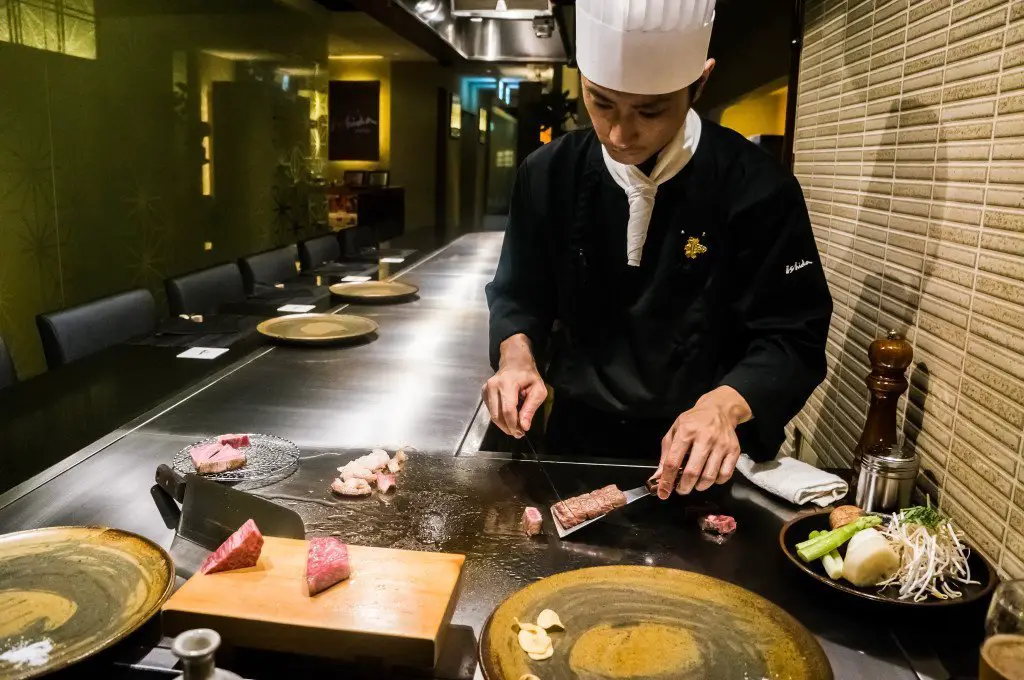
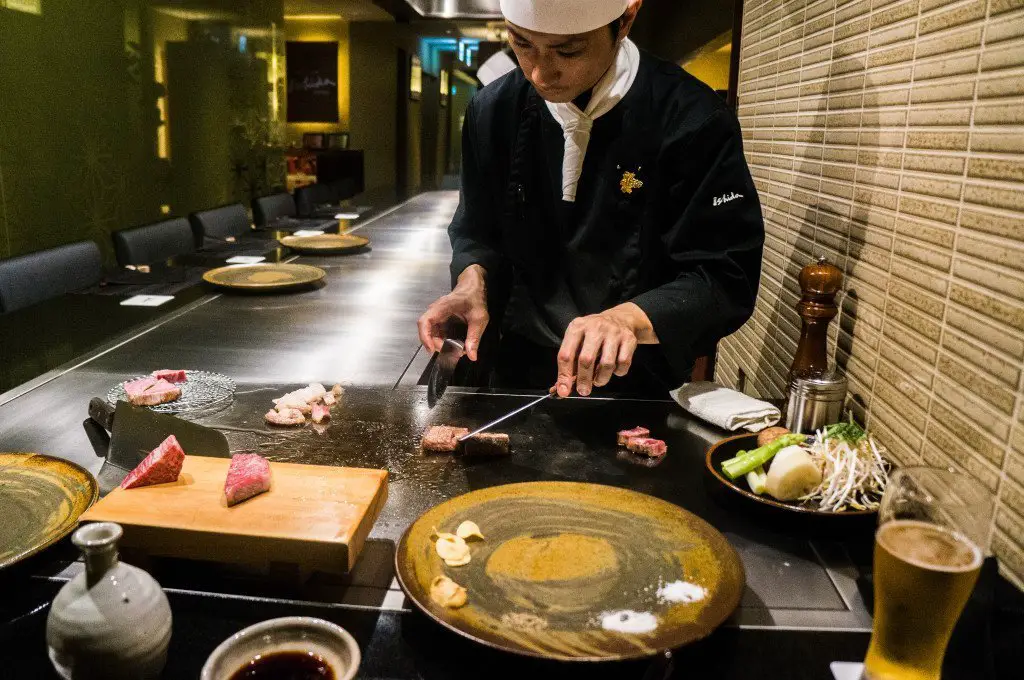
As I watched my chef expertly slice and season the juicy cuts of meat in front of me, I was salivating like a teething baby and my mouth was eager to fill the emptiest of voids in my stomach. I had to tell myself to calm down so I wouldn’t inhale all 130g in 2 minutes (which I am very capable of doing). Thankfully, the chef read my mind and expertly sliced the meat into small pieces and served them to me one by one.
The first bite hit my tongue and was the juiciest, most tender piece of meat I’ve ever chewed. People always use the phrase “it’s so good it melts in your mouth” even if it doesn’t actually melt in your mouth to signify how otherworldly something tastes. This is no joke with Kobe beef. After 5 or 6 bites, the meat was ready to swallow as all the fat had completely dissolved into the meat.
I asked my chef there’s no way this can be healthy because it’s not as tender but he assured me that the fat from Kobe beef is not akin to the unhealthy high cholesterol fat from regular American beef. Let’s not get ahead of ourselves, he didn’t say it was healthy either. As far as fat from cows go, you’ll be getting high blood pressure at a much slower rate from Kobe beef.
By this point, I couldn’t care less what diseases I could get and proceeded to devour the rest of my precious pieces of meat. Even my girlfriend who always let’s me sample some her food defended her food like she hadn’t eaten in days.
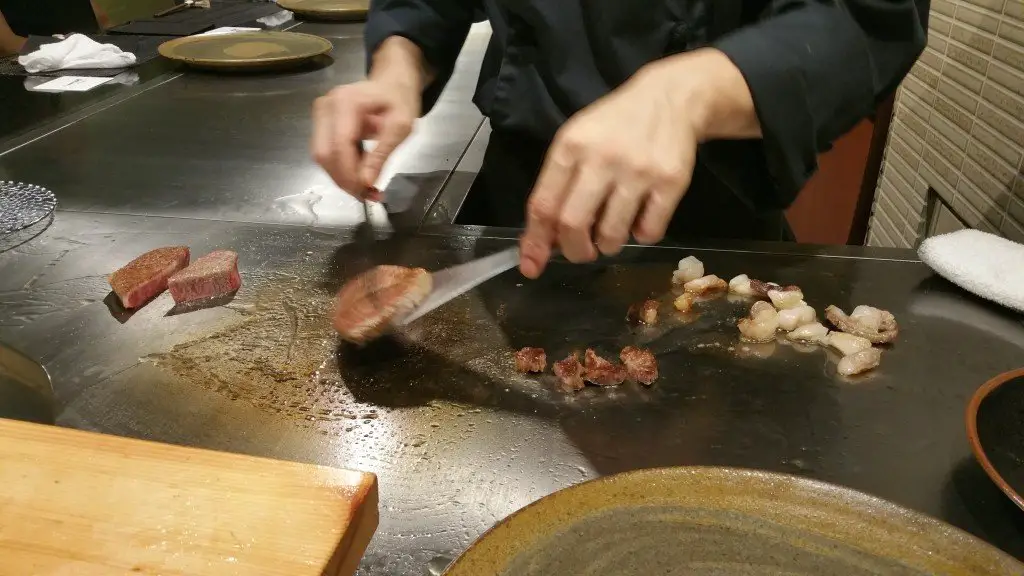
When the food was finished, I don’t think I’d ever been in a sadder state of life. I just couldn’t believe it was over, and quickly realized that getting the 130g portion of sirloin was the biggest mistake I’ve made while traveling. For another 2000 yen, I could have had 70 more grams. You live and learn, and hopefully have Kobe beef again someday…
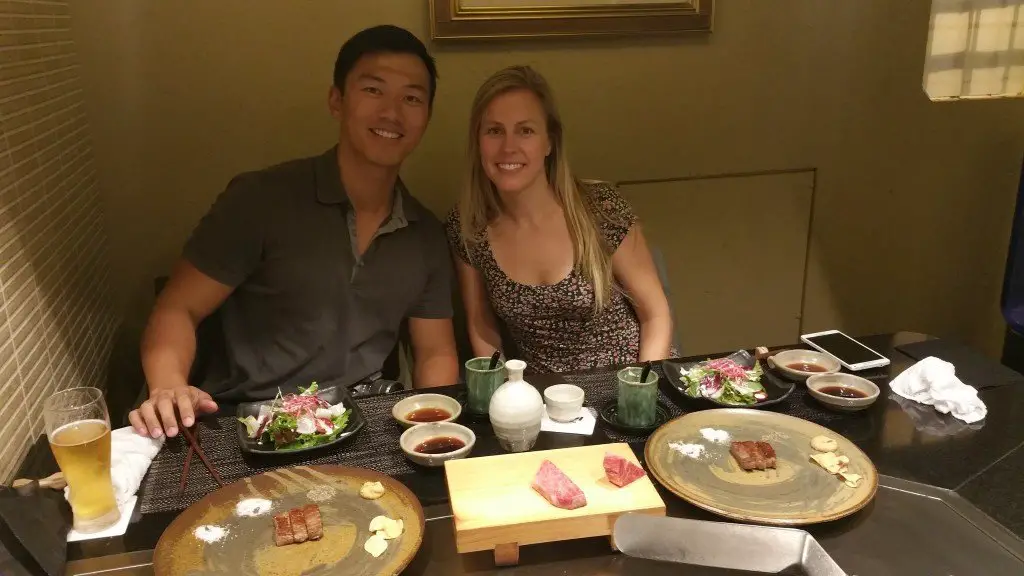
Fried Rice Course
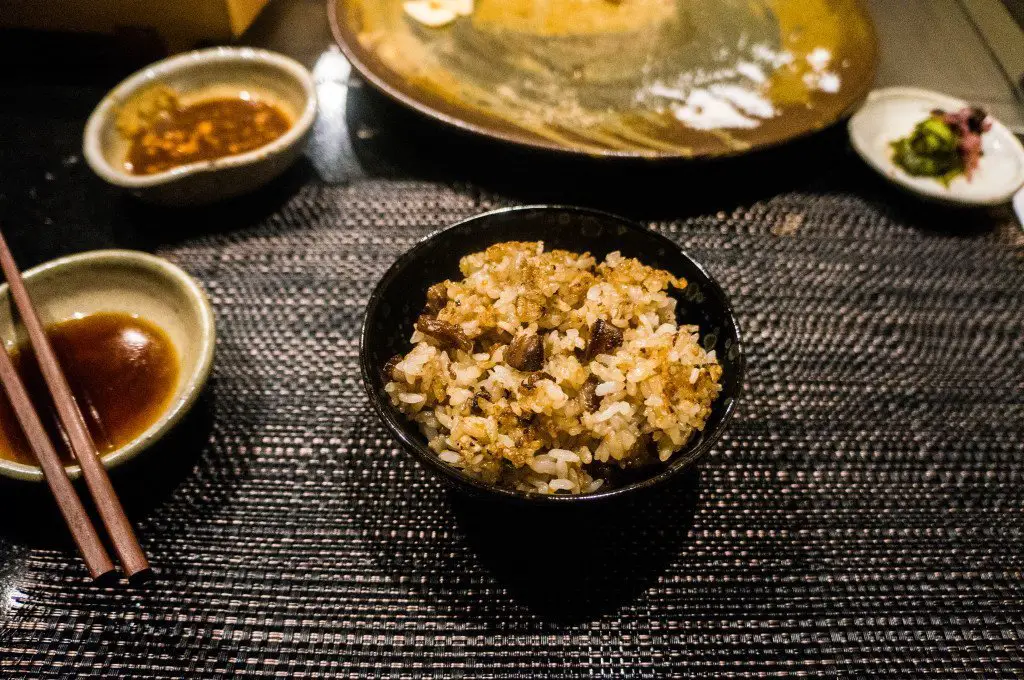
I suppose for those that didn’t order enough meat, this course is a good consolation to assure you’ll be full. The fried rice is expertly cooked on the grill with the leftover fat and trimmings from the meat. The fat does wonders to any dish and it is the perfect way to take fried rice to the next level. I proceeded to wolf this course down too as I was still famished after demolishing the sirloin in the previous course.
Dessert
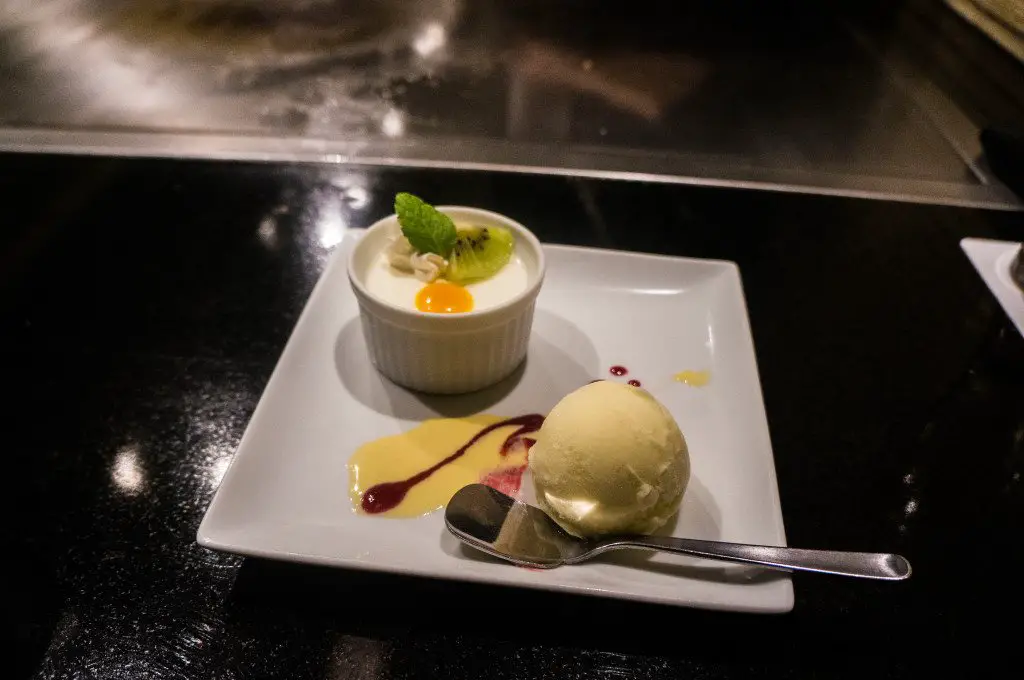
An above average offering of Japanese style sweets to top of the course. This did nothing to me except make me seriously contemplate ordering more meat.
IMPORTANT TIP: Whatever you do, eat Kobe Beef in Kobe for LUNCH!!! It’s half the price, for the exact same sized portions. Had we known, we would have planned accordingly!
The bill *sad face*
Well, you can’t have the good things in life without a little money, or quite a bit of money in the case of eating Kobe beef.
These are the items we had for dinner:
- 1 beer
- 1 300ml of sake
- 1 130g sirloin tasting (fat marbling: 7 out of 12)
- 1 110g tenderloin tasting (fat marbling: 7 out of 12)
The final bill came out to be 26,500 yen, or about $215 at the exchange rate on that day. Also, we had one of the lowest quality of Kobe beef (which still blew my mind) with a fat marbling scale of 7 out of 12. There were some cuts at 10-11 out of 12, and these were almost 50% more expensive so we could have easily spent far more money.
Kobe Beef changed my life
And certainly not for the better. Whenever I eat regular steak, it doesn’t even come close to matching the same intense, delicious flavor that I had experienced on this special night. Everything seems so plain. I was also saddened that I would never be able to eat this meat again unless I either returned to Japan or found one of the few restaurants in America serving Kobe beef and pay 3x as much. Or would it be?
Turns out, the next place I visited in Japan in the Okinawan island of Ishigaki had something even better than Kobe beef…



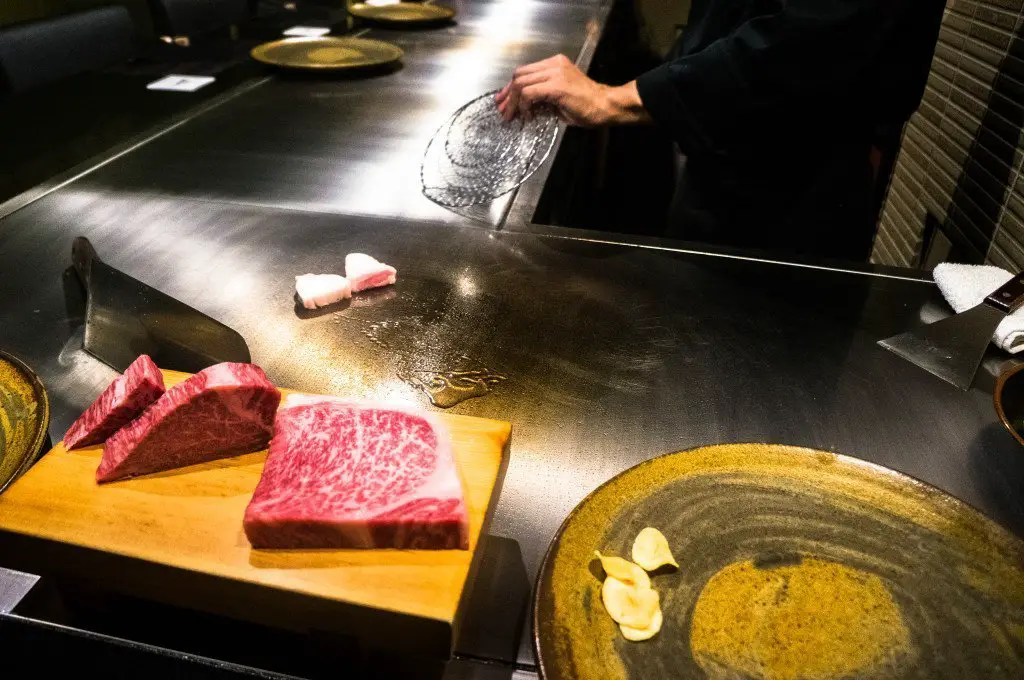






Now that good science has shown that dietary fat/cholesterol is a non-issue with regard to CVD (Cardio-Vascular Disease) we can eat as much Kobe Beef as we can afford, and the more the marbling (fat) the better.
Haha that was not stopping me either way but bring on the wagyu now!
Kobe beef gets a lot of hype because it’s a well known name, but it isn’t even the best wagyu. That award most recently went to Kagoshima, if I recall.
Yes totally! Kobe never been at the top. They were just the most successful at marketing the name and making it synonymous with super high end Japanese beef!
Where did you visit or what did you eat in Japan that was even better than Kobe beef?!
Hi Ivana, simple 🙂
I went to Ishigaki afterwards, which is home to Ishigaki beef. ALso the same cows that eventually get shipped off to Kobe and become kobe cows. Not only can you eat similar quality beef, but the cost is half and the beaches there are amazing!
I want to live it all over again. So delicious!